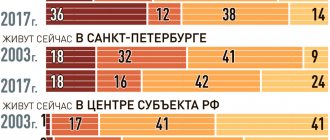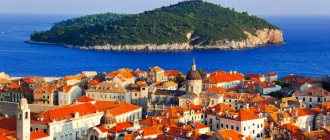Migration (mechanical movement of the population) is the movement of people from the territory of their permanent residence to another place of residence within the state of which they are citizens or beyond its borders. As a result, a process of territorial redistribution occurs, as well as quantitative changes within the migration group. There are different types of migration, differing in the reasons why people move. The meaning of the word “migration” can be explained as absolutely any movement of population groups or individual members of society between different territories. In a narrow concept, this term means the final type of territorial movement, as a result of which people change their permanent place of residence.
Reasons for population migration
Important! Please keep in mind that:
- Each case is unique and individual.
- A thorough study of the issue does not always guarantee a positive outcome. It depends on many factors.
To get the most detailed advice on your issue, you just need to follow any of the suggested options:
- Use the online chat in the lower corner of the screen.
- Call:
For all regions of the Russian Federation: +7 (800) 511-86-74
Every day people move from village to city, from city to regional center, from country to country. There are many reasons for this and everyone has their own. Some leave in order to improve their material well-being, others are simply forced by various circumstances.
In this regard, we can identify the main reasons why the population migrates:
- unstable economic, environmental, situation in the place of residence;
- persecution on religious, national, ethnic grounds;
- threat to life (wars, man-made disasters);
- moving to the historical homeland;
- searching for a better place for training and further employment.
The reasons and nature of the migration process are shown in the picture.
Internal migrations of the population of Russia in the last decade
Over the past centuries, the population of Russia has been moving north and east. Agrarian overpopulation, the need to populate the vast Siberian expanses, the industrialization of the eastern regions of the country, which sharply increased during the war years due to the evacuation of thousands of factories, the post-war development of natural resources - these were the main reasons that accompanied the not always voluntary resettlement.
The outflow of population came from the Central Black Earth, Volga-Vyatka and Ural regions (the first two had been losing population since the end of the 19th century, the Urals - since the 50s of the 20th century), a number of regions of the Center and the Volga region. At the same time, Moscow, Leningrad and some regions located near them steadily attracted the population. In 1970-1978 positive migration growth in the population of the Central region was ensured by Moscow, the Moscow and Vladimir regions, in 1979-1988. some other regions joined them.
Due to migration, the population of the lowland Ciscaucasia grew, while the population left most of the national republics.
The process of population movement to the east was not uniform; not all territories east of the Urals attracted migrants.
So, in the 60s. Western Siberia lost 800 thousand people due to migration; there was also an outflow of population from Eastern Siberia (). A slight negative migration balance in these areas persisted in the 70s (see table 1). Table 1. General rates of migration growth (loss) by economic regions of Russia in recent decades
(
per 10,000 population
)
| 1970-1978 | 1979-1988 | 1989-1998 | |
| Russia, total | 1 | 13 | 21 |
| Northern | 5 | 7 | -50 |
| Northwestern | 78 | 56 | 27 |
| Central | 25 | 34 | 38 |
| Volgo-Vyatsky | -47 | -27 | 22 |
| Central Black Earth | -49 | -18 | 68 |
| Povolzhsky | 11 | -1 | 48 |
| North Caucasian | 11 | 4 | 49 |
| Ural | -51 | -28 | 19 |
| West Siberian | -9 | 58 | 18 |
| East Siberian | -9 | 5 | -21 |
| Far Eastern | 70 | 45 | -102 |
Sources: Number, composition and movement of the population in the RSFSR. ? M.: RIITs Goskomstat RSFSR, [b.g.] ? pp. 46-47; Population of Russia, 1999: Seventh annual demographic report / Ed. A.G. Vishnevsky. ? M., 2000. ? P. 145
A stable migration increase in population went to the Far East, with a slight outflow in the 70-80s. was only from the Sakhalin region.
The situation began to change in the second half of the 80s, when a slight outflow of population from the Russian North began. At the same time, the outflow from most regions of the European part of the country stopped. What caused this? First of all, the first sprouts of the market economic system opened up for socially active people, who formed the basis of the migrant contingents, the opportunity to receive high earnings not thousands of kilometers away, but in their own city or village. There were much fewer incentives to go for the “long ruble”, and besides, the administrative and distribution system had cracked, the previously good supply of northern cities and towns was disrupted. In such a situation, many were in no hurry to change their place of residence, and the population of ten million in the Russian north froze in anxious anticipation.
When the Soviet Union and the socialist economy began to disintegrate, the population began to hastily leave the North, where the former state-established benefits and wage increases in conditions of galloping inflation not only lost their stimulating role, but also did not ensure the maintenance of a decent standard of living. In addition, in many cities and towns, the social sphere was collapsing, and unemployment made itself known. Many people from the former Soviet republics (Ukraine, Belarus) rushed back to their “national apartments”, afraid of losing the housing they had booked in their homeland and their accumulated pension experience.
The central and southwestern regions of the country became attractive in terms of migration, where, moreover, there was an influx of forced migrants and repatriates from the former republics, demobilized military personnel from disbanded military units. The picture of the territorial movement of the population of Russia has changed radically, interrupting for a long time (and maybe forever) the population movement to the north and east of the country that has continued for centuries.
In recent years, much has been said about the influx of population into the country, unprecedented in Russian history, about the repatriation of Russians and other ethnic Russians, about the forced migration that accompanied armed conflicts in the ruins of the former USSR. Internal Russian migration, which is significantly larger in scale than external migration, has been somewhat overlooked by scientists and publicists.
Over 12 years (from 1989 to 2000), the migration turnover of the Russian population amounted to 52.4 million people. This does not mean that so many residents of the country participated in migration, because... one person could make migration movements more than once during this period of time; this is the total volume of migrations recorded by statistics.
At the same time, 3/4 of migration movements were carried out within Russia. 55% of migrations took place within regions, territories, republics, 45% - between individual regions of the country.
For 1989-2000 the share of internal migration in the total volume of relocations did not decrease below 66% in 1994-1995. - the time of maximum influx into the country from the CIS and Baltic countries; in recent years, it accounts for more than 80% of all migration movements.
The number of relocations - both internal and external - during the 90s. decreased continuously: in 2000, the total number of migration movements amounted to 2.8 million people compared to 6.3 in 1989.
The reduction in internal migration turnover occurred simultaneously in all districts of the Russian Federation (Figure 1). The most dramatic reduction in migration intensity occurred at the very beginning of the 90s. Then, in 1994-1995. Some growth was noted, but since 1996 the volume of resettlement began to decline again everywhere. The decrease in migration volumes is a consequence of a serious crisis; it complicates the establishment of normal market mechanisms for the functioning of the labor and housing markets.
Despite the fact that the intensity of migration has decreased everywhere, it is noteworthy that over the decade the districts of the eastern part of the country were characterized by a relatively higher migration turnover.
Figure 1. Turnover of intra-Russian migration by federal districts in 1991-2000
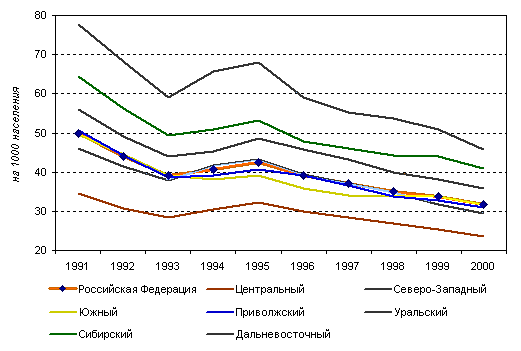
At the end of the 90s. the flow of population between different parts of the country is decreasing. In 2000, only the Central District demonstrated a stable migration increase due to intra-Russian migration. On the other hand, at the outflow pole, in the Far Eastern District, the migration loss is losing intensity (Figure 2).
Figure 2. The intensity of migration growth (loss) of the population in 1991-2000 (per 10 thousand resident population)
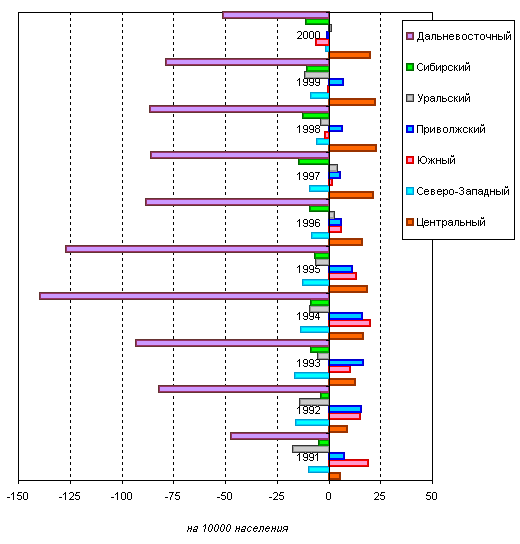
In addition to the decrease in the scale and intensity of intra-Russian migrations, there was a change in their directions. After the change at the turn of the 80-90s. the main direction of migration, the picture of internal migration did not remain static. The matrix of interdistrict migration (the so-called “checkerboard”) (), built for the federal districts of the Russian Federation (Table 2), will help to evaluate it. When constructing the matrix, we used data only on arrivals, which allows us to avoid common discrepancies in the number of arrivals and departures for Russia as a whole due to undercounting of departures. These tables allow us to evaluate not the volume of migration between federal districts, but its effectiveness.
Table 2. Net migration between federal districts of the Russian Federation in 1991-2000, people
| 1991-2000 | ||||||||
| Balance for territory | ||||||||
| Russia, total | Center | S.-Zap | Southern | Privol | Ural | Siberia | D.-Vost | |
| In exchange with the territory | ||||||||
| Russia, total | 0,0 | 618,3 | -148,6 | 165,1 | 294,6 | -73,8 | -185,9 | -669,8 |
| Central | -618,3 | 0,0 | -134,3 | -89,9 | -38,2 | -51,8 | -104,3 | -199,8 |
| Northwestern | 148,6 | 134,3 | 0,0 | 31,3 | 63,5 | -4,4 | -23,0 | -53,1 |
| Southern | -165,1 | 89,9 | -31,3 | 0,0 | 19,4 | -26,4 | -66,8 | -149,9 |
| Privolzhsky | -294,6 | 38,2 | -63,5 | -19,4 | 0,0 | -59,4 | -72,4 | -118,1 |
| Ural | 73,8 | 51,8 | 4,4 | 26,4 | 59,4 | 0,0 | -28,1 | -40,2 |
| Siberian | 185,9 | 104,3 | 23,0 | 66,8 | 72,4 | 28,1 | 0,0 | -108,8 |
| Far Eastern | 669,8 | 199,8 | 53,1 | 149,9 | 118,1 | 40,2 | 108,8 | 0,0 |
Table 2 shows that over the last decade, the Central, Volga and Southern federal districts had a positive balance of intra-Russian migration; they received 1,078 thousand people due to migration with other districts, the rest were losing population. At the same time, the Central District attracted population from all districts, the Volga District - from all but the Central, the Southern - from all except the two above-mentioned. The Far Eastern District gave up its population to everyone else.
Having thus compared the balances of individual districts with each “migration partner,” we ranked them by performance in the following sequence:
| Rank | 1 | 2 | 3 | 4 | 5 | 6 | 7 |
| 1991-2000 | |||||||
| Center | Privol | Southern | S.-Zap | Ural | Sibirsk | D.-Vost | |
| Net migration, total, thousand people | 618,3 | 294,6 | 165,1 | -148,6 | -73,7 | -185,9 | -669,8 |
| incl. "+" | 618,3 | 332,8 | 274,5 | 80,5 | 68,3 | 108,8 | |
| «-« | -38,2 | -109,3 | -229,1 | -142 | -294,6 | -669,8 | |
As a result of comparing the migration balance of individual districts with each “migration partner” of the same (district) rank, we compiled similar series for the effectiveness of bilateral migration exchange for each year of the last decade. A district that has the first rank (“leader” of interdistrict migration exchange in a particular year) has a positive migration increase in population exchange with all other federal districts of Russia. The next district (second rank) has a positive balance due to migration with all districts except the first, the third rank is assigned to the district receiving population from all other districts except the first and second, etc. For districts with a lower rank, the total migration increase may be higher than for those located higher, but it is achieved due to effective migration with districts of even lower rank.
| year | Rank | ||||||
| 1 | 2 | 3 | 4 | 5 | 6 | 7 | |
| 1991 | Southern | Privol | Center | Siberia | S.-Zap | Ural | D.-Vost |
| 40,1 | 23,6 | 20,2 | -9,2 | -14,4 | -22,1 | -38,1 | |
| 1992 | Privol | Center | Southern | Ural | Siberia | S.-Zap | D.-Vost |
| 49,8 | 33,2 | 32,1 | -17,3 | -7,5 | -24,1 | -66,0 | |
| 1993 | Privol | Center | Southern | Ural | S.-Zap | Siberia | D.-Vost |
| 53,0 | 47,6 | 21,6 | -6,3 | -24,3 | -18,0 | -73,6 | |
| 1994 | Privol | Center | Southern | Ural | S.-Zap | Siberia | D.-Vost |
| 51,3 | 63,1 | 43,2 | -11,1 | -20,2 | -17,8 | -108,6 | |
| 1995 | Center. | Privol. | Southern | North-West | Ural. | Siberia | D.-East. |
| 70,8 | 37,3 | 28,5 | -18,2 | -7,5 | -14,1 | 96,8 | |
| 1996 | Center. | Privol. | Southern | Ural. | North-West | Siberia | D.-East. |
| 60,4 | 20,0 | 13,3 | 3,1 | -11,5 | -19,0 | -66,3 | |
| 1997 | Center. | Ural. | Privol. | Southern | North-West | Siberia | D.-East. |
| 80,8 | 5,0 | 18,2 | 3,2 | -13,1 | -30,5 | -63,6 | |
| 1998 | Center. | Privol. | Southern | North-West | Ural. | Siberia | D.-East. |
| 85,4 | 20,4 | -3,7 | -8,4 | -4,7 | -25,7 | -63,3 | |
| 1999 | Center. | Privol. | Southern | North-West | Ural. | Siberia | D.-East. |
| 82,9 | 23,3 | -0,5 | -12,6 | -14,3 | -21,6 | -60,0 | |
| 2000 | Center. | North-West | Ural. | Privol. | Southern | Siberia | D.-East. |
| 73,9 | -1,6 | 1,6 | -2,3 | -12,6 | -22,4 | -36,6 | |
| 2001 | Center. | North-West | Ural. | Southern | Privol. | Siberia | D.-East. |
| 72,6 | 6,6 | 3,5 | -11,9 | -13,5 | -26,1 | -31,2 | |
This ranking of the federal districts of the Russian Federation according to the effectiveness of bilateral migration ties allows us to assess their “place” in the country’s migration field. As we can see, the districts have changed places over the past decade. The Southern Federal District, which initially led in bilateral migration exchange, gave way to the Volga and Central, and then to the Ural and even Northwestern. The situation in the Siberian District worsened in the second half of the 90s. - Privolzhsky. On the contrary, the Central District, which ranked third in 1991, has firmly held first place since 1995. The positions of the Ural and Northwestern districts have become better. Only the Far Eastern District consistently ranked last, giving population to all districts without exception throughout the decade.
It is interesting to note that in the years of relative (as far as this can be in Russian conditions) economic prosperity (1997, 2000-2001), the position of the Ural and Northwestern districts improves, they occupy correspondingly higher ranks; on the contrary, during the deterioration of the general economic situation (1998-1999), they occupy less good positions, inferior to the Southern and Volga districts. The increasing trend of the North-Western District in recent years is largely due to the attractiveness of St. Petersburg and the Leningrad region.
In the first half of the 90s. Moscow has, to a certain extent, lost its role as a center attracting migrants. According to official statistics, due to intra-Russian migration in 1991-1995. its migration increase amounted to only 11 thousand people, which is negligible compared to the old days (). Moreover, in 1992-1993. Moscow was losing population, as was St. Petersburg and many other Russian cities. Such trends gave rise to judgments about a reversal of the urbanization process, about a violation of its stages. All this affected the migration results of the Central and Northwestern districts.
However, since the second half of the 90s. The results of migration once again forced people to talk about Moscow as the most powerful “magnet” for migrants from all regions of the country. For 1996-2000 Only due to intra-Russian migration, the capital received 207.9 thousand migration growth. On average for the year this is not much - a little more than 40 thousand people, but this is more than in any other region of Russia, and this is 54% of the increase in the entire Central Federal District. At the beginning of 2001, the population of Moscow was 23.3% of the population of the Central Federal District.
Where did Moscow take so many migrants from? The main migration “donor” for it was other subjects of the Central District - they provided 40% of the migration increase. The neighboring Southern, Volga and Northwestern districts provided almost the same amount. The regions of the eastern part of the country accounted for less than a quarter of the capital's migration growth.
Consideration of the effectiveness of migration within the Central District shows that out of 84 thousand of Moscow’s migration growth, 30.1 thousand were provided by the Moscow region, almost the same amount - 28.8 thousand - were provided by five neighboring regions - Tver, Vladimir, Ryazan, Tula, Kaluga.
In turn, the Moscow region, at the expense of other regions of the Central District, more than compensated for the outflow of population to Moscow. The main migration partners and donors are the same - neighboring regions. The capital region has a migration increase with all regions of the country - with the exception of Moscow.
The capital region can rightfully be considered the most attractive region of the country in terms of migration at present.
In the Central District, only one region, with the exception of Moscow and the region, has a positive balance of migration within the district - the Belgorod region. It gives the population only to Moscow and the region and St. Petersburg, with all other regions of the country it has a positive migration balance. And the outflow of population to the capital region over the past 5 years has amounted to less than 2 thousand people.
The Lipetsk, Oryol, Voronezh, and Yaroslavl regions, located some distance from Moscow, have good migration results within the Central District.
This example clearly shows the centripetal nature of migration processes in modern Russia. The Central District itself attracts population from all other federal districts; within the district, the population is drawn to the capital region, and residents of the Moscow region are actively moving to Moscow.
Of course, the population movement to Moscow in recent years has surpassed all other migration flows in power, but the spatial movement of the population is far from being exhausted by this. In recent years, several more large centers have formed on the territory of the country, actively attracting people from both neighboring and remote regions.
First of all, following Moscow, the position of St. Petersburg improved. In the early 90s. the city experienced a migration decline in population exchange with other Russian regions - -17.7 thousand. The Leningrad region had better results - 28.4 thousand people, but this was due to its positive balance with St. Petersburg.
In the second half of the 90s. St. Petersburg and the region received 81.3 thousand people due to intra-Russian migration; the outflow of population went only to Moscow and the region and, insignificantly, to neighboring Novgorod. At the same time, the loss with the capital region was completely compensated by other regions of the Central District. Unlike Moscow and the region, for the second capital, migration from the districts of the Asian part of the country plays a much larger role, which provides 44% of the migration increase. The European “North” plays a big role - migration from there to St. Petersburg and the region is much more intense than to the capital. Therefore, this region can rightfully be considered the second most important migration center on an all-Russian scale.
In the Volga District, the region that has a positive balance of migration with all others is the Nizhny Novgorod region. It suffers significant migration losses only in exchange with the capital region. However, the Nizhny Novgorod region is not such a dominant center as those that we described earlier; it has a number of large competitors in its own district - the Republic of Tatarstan, the Samara region. Only due to these regions, the Volga Federal District ensures a positive migration balance in intra-Russian migration: their total migration growth for 1996-2000. amounted to 91.7 thousand people (the total Volga District is 79.5 thousand. These regions have a stable and significant migration decline only with the regions of both capitals.
In the south of Russia there are regions with a significant increase in intra-Russian migration. These are the Krasnodar (78.1 thousand for 1996-2000) and Stavropol (36.8 thousand) regions, united together under the name “plain Ciscaucasia”. In the early 90s. these were the most attractive regions of the country for migrants. Migration within the district is very important for their migration balance: for the Stavropol Territory it provides almost the entire migration increase, for the Krasnodar Territory - almost 40% of the increase. A very large share is made up of migration from Chechnya.
At the same time, the Krasnodar Territory has highly intensive migration connections with many regions of Siberia, the Far East and the European North. This makes it a major inter-district migration center.
In the south of Siberia there is another large - but already local - migration center - the Novosibirsk region. Having virtually a zero (slightly negative) migration balance with the Ural, Volga, Southern and Northwestern districts, it attracts people from all regions of Siberia and the Far East.
Further east, no region can claim to be even a local migration center. All of them are either experiencing a strong migration decline, or more or less successfully compensate for the migration outflow to the more western regions of the country at the expense of their neighbors located to the north or east of them.
So, in the second half of the 90s. The Khabarovsk Territory, having a migration loss with all districts located to the west, made up for almost 30% of the migration loss at the expense of the Far East. During the same period, the Irkutsk region, due to regions located to the east, compensated for almost 50% of migration losses with the western parts of the country.
In Russia throughout the 90s. there was a stable and territorially fairly compact zone of population outflow. These are the regions of the European North (Murmansk, Arkhangelsk regions, the Komi Republic), part of the regions of Siberia (Krasnoyarsk Territory, Chita, Irkutsk and Tomsk regions with districts, the Republic of Buryatia and Tyva) and the Far East. We did not include the Khanty-Mansi and Yamalo-Nenets districts in the zone of stable population outflow, because the first has been attracting population in recent years, and the migration loss of the second is relatively small. In addition, until 1996, there is no separate information on them - they were merged with the Tyumen region, located much to the south.
For 1991-2000 Only due to intra-Russian migration, the listed regions lost almost 1.3 million people, or about 6% of the population at the beginning of the 90s. Among them there are regions from which the outflow to other regions of the country was much more intense - the Chukotka Autonomous Okrug and the Magadan Region, the Murmansk Region, the Republic of Sakha (Yakutia).
The migration losses of the regions of the “giving” zone are naturally comparable to the gains of the “receiving” zone (Central, Volga districts, part of the North-Western and Southern districts), but this does not mean that the population exchange between them occurs directly: between these zones there is a group of regions with a migration balance close to zero, which receives population from the outflow zone and sends it to the receiving zone. These are primarily the regions of the Urals and southern Siberia. Some of these regions - for example, the Orenburg, Kurgan regions, in recent years - and the Altai Territory, having a negative balance of migration exchange with other Russian territories, more than make up for it through external migration, primarily with Kazakhstan and the states of Central Asia.
Where do northerners and residents of the eastern regions of the country go? Considering the large extent of the receding zone, we consider it advisable to divide it into three parts: the European North, the North of Siberia and the Far East.
The regions of the European North (Murmansk, Arkhangelsk regions, the Komi Republic and the Nenets Autonomous Okrug) give their population mainly to the Center and other regions of the North-West (Figure 3). The outflow to the regions of the Asian part of the country is very small, and with the Far Eastern District, the European North even has a small increase in migration (in 1996-2000 - 1.1 thousand people). The most powerful migration flows are directed to St. Petersburg and the Leningrad region, the capital region, Krasnodar region, Nizhny Novgorod and Belgorod regions (in total, these regions account for 40% of migration losses).
Figure 3. Distribution of migration loss of regions of the European and Siberian North, Far East by federal districts in 1996-2000
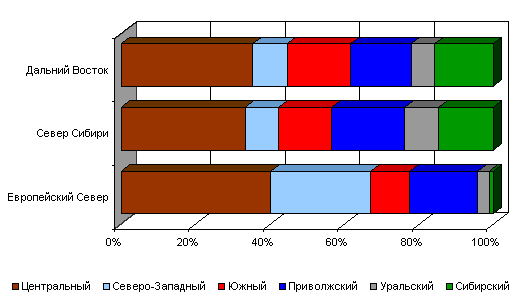
* numbers indicate modular values of migration loss
The regions of Northern Siberia are also losing population with all districts, with the exception of the Far East. However, the migration “gain” due to the latter is small and makes up for less than 10% of the outflow to other regions of Siberia and districts located to the west. The main places of outflow are the regions of southern Siberia, the Central, Volga and Southern districts. The most significant migration decline occurs in the Siberian North with the Novosibirsk region; also, in addition to the most attractive regions of the European part of the country in terms of migration, the outflow goes to the Chelyabinsk, Sverdlovsk regions, and the Republic of Khakassia.
The Far East is a zone of continuous migration outflow. The departure goes both to the Siberian and Ural districts (22% of total losses), and to the districts of the European part. Compared to the Siberian North, a more significant outflow goes to the Southern District; A number of regions of the Far East have established long-standing, highly intensive migration connections with the south of Russia.
Within the Far East, intra-district migration is also of interest. It is directed from the North to the South - to the Khabarovsk, Primorsky Territories, the Jewish Autonomous Okrug and the Amur Region. And although the total outflow in the second half of the 90s to these regions from the north was the same as to the capital region (almost 20 thousand people), this flow deserves attention.
Another important feature of the migration of northerners is the weak migration exchange of population between neighboring regions of the North. So, in 1996-2000. A little more than 0.5 thousand people left the Magadan region for the Republic of Sakha (Yakutia), while 2.1 thousand left for the remote Belgorod region. Over the past 5 years, less than 0.6 thousand people have arrived in the Chukotka Autonomous Okrug from the neighboring Magadan, Kamchatka regions and Yakutia, while more than 0.7 thousand have arrived from the Krasnodar Territory and Rostov Region. It is no coincidence that northerners call the southern regions of the country “the mainland”: they look like separate islands, between which there is virtually no transport communication or migration contacts.
A stable zone of migration outflow for only the last decade, but also the previous ones, are the national republics of the North Caucasus (with the exception of Adygea, populated mainly by Russians), to which Kalmykia was previously territorially and now administratively adjacent. In the second half of the 90s. The outflow from these regions to other parts of the country amounted to approximately 140 thousand people (). The specificity of the region is that its main decline is shared with other regions of the Southern District. Half of the migration losses of the national republics with other regions of the Southern District occurred in the Stavropol Territory, another quarter in the Krasnodar Territory. A significant outflow goes to the regions of both capitals.
The picture of migration processes within Russia will be incomplete without one more component. A number of regions located in Central Russia are experiencing a migration decline. While there was an intense migration influx from the CIS states and the Baltic countries to this part of the country, such features of intra-Russian migration were not noticeable. However, in 2001, a sharply reduced (at least registered) influx of migrants created a situation where in central Russia migration was added to the widespread natural population decline.
In 1996-2000 The outflow of population due to intra-Russian migration was experienced by the Kursk, Smolensk, Tula, Tambov, Ryazan regions, and the Republic of Mordovia. The population decline goes mainly to other regions of the Center.
Table 3. Balance of intra-Russian migration for some regions of Central Russia in 1996-2000
| Regions | Migration loss? total, thousand people | Incl. with other regions of the Central Federal District |
| Kursk region | -3,1 | -9,7 |
| Ryazan Oblast | -5,6 | -11,2 |
| Smolensk region | -3,9 | -8,3 |
| Tambov Region | -6,9 | -9,9 |
| Tula region | -1,8 | -11,5 |
| The Republic of Mordovia | -8,7 | -4,6 |
There is also a migration outflow from the Republic of Mordovia to other regions of the Volga District.
Among the regions of Russia in the last decade, “leaders” and “outsiders” have emerged in terms of the effectiveness of migration exchange (see Table 4). As you can see, all regions that actively attract population are located in the European part of the country, most of them have the largest urban centers. On the contrary, the sending regions are located mainly in the Asian part, all of them (with the exception of the Chechen Republic, which is not included in the table due to the lack of reliable data on the migration of its population) are also fully or partially classified as regions of the Far North and equivalent areas.
Table 4. Ranking of Russian regions by the value of the balance of intra-Russian migration in 1991-2000 (thousand people)
n ? number of ranks
| » rank | Region | Net migration with Russia, total | Incl. with districts: | ||||||
| Center | S-Zap | Southern | Privol | Ural | Siberia | D-East | |||
| n0 | Krasnodar region | 237,9 | 2,3 | 23,4 | 78,5 | 7,9 | 26,8 | 34,2 | 64,9 |
| n0 + 1 | Moscow | 218,9 | 85,4 | 22,6 | 33,1 | 17,8 | 16,5 | 18,5 | 24,9 |
| n0 + 2 | Moscow region | 139,2 | 11,8 | 23,4 | 19,7 | 19,2 | 11,5 | 20,2 | 33,4 |
| n0 + 3 | Stavropol region | 118,2 | -7,2 | 3,3 | 89,6 | -0,4 | 3,8 | 9,5 | 19,5 |
| n0 + 4 | St. Petersburg with the area | 92,0 | -12,0 | 35,5 | 9,1 | 1,0 | 9,6 | 17,7 | 31,1 |
| n0 + 5 | Samara Region | 76,9 | -0,3 | 7,4 | 4,9 | 17,1 | 16,9 | 11,8 | 19,2 |
| n0 + 6 | Belgorod region | 67,1 | 10,9 | 11,0 | 9,0 | 2,9 | 5,9 | 10,0 | 17,6 |
| n0 + 7 | Volgograd region | 61,7 | -0,5 | 8,3 | 15,5 | 1,4 | 9,0 | 9,8 | 18,4 |
| n0+8 | Nizhny Novgorod Region | 60,2 | -1,3 | 14,0 | 5,2 | 10,4 | 5,3 | 10,3 | 16,3 |
| n0 +9 | Rostov region | 59,5 | -7,6 | 8,4 | 8,9 | -1,1 | 3,7 | 13,7 | 33,4 |
| n-9 | Arkhangelsk region (with Nenets Autonomous Okrug) | -62,8 | -23,9 | -17,3 | -8,1 | -10,5 | -2,4 | -1,2 | 0,7 |
| n-8 | Primorsky Krai | -74,3 | -28,9 | -8,5 | -15,7 | -18,1 | -6,1 | -14,4 | 18,4 |
| n-7 | Chita region (with Aginsky Autonomous Okrug) | -79,1 | -17,9 | -5,4 | -11,6 | -12,1 | -4,7 | -24,4 | -3,0 |
| n-6 | Sakhalin region | -86,9 | -23,8 | -5,6 | -17,1 | -13,2 | -3,5 | -10,4 | -13,3 |
| n-5 | Kamchatka region (with Koryak Autonomous Okrug) | -89,5 | -25,5 | -8,5 | -20,1 | -12,5 | -3,0 | -9,2 | -10,7 |
| n-4 | Komi Republic | -93,6 | -37,8 | -8,5 | -15,7 | -27,7 | -3,3 | -1,9 | 1,3 |
| n-3 | Krasnoyarsk Territory (with districts) | -118,2 | -36,4 | -9,2 | -21,3 | -25,3 | -8,3 | -29,2 | 11,5 |
| n-2 | The Republic of Sakha (Yakutia) | -154,4 | -36,6 | -9,5 | -31,4 | -25,9 | -9,1 | -34,9 | -6,9 |
| n-1 | Murmansk region | -157,6 | -56,4 | -51,1 | -19,2 | -24,7 | -3,9 | -2,4 | 0,1 |
| n | Magadan region (with Chukotka Autonomous Okrug) | -159,8 | -43,8 | -10,8 | -37,0 | -20,0 | -8,3 | -23,4 | -16,4 |
It seems that dividing the territory of Russia into receiving and sending parts means significantly simplifying and blurring the vivid picture of migration interaction between the regions of the country. The examination of bilateral migration ties between Russian regions made it possible to determine the main directions of interregional redistribution of the population of Russia:
- East - West. This is a trend that has been consistent throughout the last decade.
- The Central Russian regions are the largest megalopolises (primarily Moscow and St. Petersburg). This old trend has manifested itself with particular severity in the last three to four years.
- The national republics of the North Caucasus are the lowland Ciscaucasia, the largest cities of the Center and the Volga region. The trend is stable.
Other important areas of redistribution of the population of Russia:
- North of the Far East - South of the Far East;
- European North - St. Petersburg and Leningrad region;
- Far East - lowland Ciscaucasia;
- The regions bordering Kazakhstan are the urban agglomerations of the Volga region and the Urals.
It is important that a number of powerful centers of population attraction have formed on the territory of Russia, the leading role among which belongs to Moscow.
The article was prepared for the publication: Structure and dynamics of regional settlement of the Russian Federation / Institute of Geography of the Russian Academy of Sciences. M.: O.G.I. In the press.
Notes
Makarova L.V., Morozova G.F., Tarasova N.V. Regional features of migration processes in the USSR. - M.: Nauka, 1986. - P. 27.
Such a matrix makes it possible to evaluate not only the overall result of migration for a single territory, but also migration with other territories of the same rank.
It is worth mentioning that migration to Moscow at all times was largely unregistered due to the rigid registration system and subsequently the difficulties of registration. But in the early 1990s these restrictions were no more stringent than in the 1970s or 1980s, and the decline in migration to Moscow was likely real.
The figure is approximate, because the Chechen Republic does not keep records of arrivals
Types of migration
The migration process is very complex and diverse. The population is constantly moving. Everyone's goals and reasons are different. Each country has special bodies (migration service) that monitor the movement of the population and study its specifics. This is necessary to prevent negative consequences that could provoke uncontrolled flows of illegal immigrants. Types of population migration vary in duration, legality, and scale.
By the nature of border crossings
In direction, the migration process can be external and internal. Internal migration involves the movement of people within one state. Types of internal migration include pendulum, seasonal, and rotational movement within the territory of one state. External migration is the process of relocation of citizens from one country to another.
Moreover, this process includes the following types of external migration:
- Immigration, that is, the entry of citizens of one state into the territory of another.
- Emigration is leaving one’s country for subsequent stay (temporary or permanent) in a foreign country.
Important! Thanks to external migration, states such as Australia and New Zealand and the USA were once formed. In them, the number of migrants significantly exceeds the proportion of natives.
In the Russian Federation, migration processes are regulated by Decree of the Government of the Russian Federation of April 15, 2014 N 298.
By scale
The flow of migrants, like a perpetual motion machine, never stops. Any person is always looking for better conditions for living and employment. But population movements are heterogeneous within states and between different countries. The types and types of migration depend on living conditions in different regions and countries, the level and stability of the economy, social development, legal and physical security of the population.
Due to the scale of displacement, migration occurs:
- Organized. In this case, large groups of people move to other areas or countries. The reasons for this process can be very diverse (change of deployment of a military unit, organized agricultural work, military operations, natural disasters).
- Unorganized migration (aka individual, personal). It implies territorial movements of one person or one family for the purpose of obtaining education, employment (that is, for personal reasons).
By time
The migration process is divided according to the time periods during which migrants are in the territory of another region or country.
In terms of time, the movement of people can be irrevocable, that is, permanent, in which people permanently move to another place for work and residence, and returnable, that is, temporary.
In turn, temporary migration is divided into long-term, in which people stay outside their usual habitat for more than 12 months, and short-term, when the period of stay in another country or city is less than a year.
Short-term temporary migration can be regular or irregular. Regular means the daily movement of people from one locality to another for work or study. This is observed in border cities or if people live in a village (village) and go to work every day to a city located in close proximity to their place of residence. This is the so-called pendulum migration.
Irregular migration involves moving at regular intervals. This process includes:
- Seasonal migration. We are talking about professions that are in demand only during certain seasons (tourism business, harvesting, holding the Olympic Games). People from different cities and even countries move during the season to places where they can find profitable temporary employment. And as soon as the season ends, they return back to their permanent place of residence.
- Watch. This type of population movement for the purpose of earning money is very similar to seasonal migration, however, it involves employment in another region or country not for a specific season, but at any time of the year for a certain period of time (2 weeks, a month, six months). After the end of their watch period, people return home, and after a while they leave their country again to continue working. Shift migration is typical for oil workers and sailors.
Legally
Migration is not always a legal process. This is due to state policy. Countries with a well-developed economy and a high standard of living have very strict requirements for people seeking to come to their territory. This leads to the emergence of illegal migrants who are denied entry, but have no desire to return to their homes. In Russia, this process is regulated by Federal Law No. 109.
There are legal and illegal migration. A migrant who enters the territory of the receiving state in accordance with its legislation is considered legal. He has all the necessary documents granting the right to live, work or study in a foreign country.
Illegal migrants are people who cross the border illegally or stay in the territory of the receiving state in violation of the norms and requirements of the law.
Such cases include:
- illegal border crossing;
- staying in the receiving state with deliberately false documents;
- staying in the territory of a foreign state after the expiration of a visa or work patent.
Voluntarily
People can be involved in migration in a variety of ways.
| Type of movement of people | Cause |
| Forced | The reasons for such displacement are cataclysms, military actions, unfavorable environmental conditions, and unstable economic conditions. |
| Voluntary | People themselves decide to leave their place of residence and move to another region or country. |
| Forced | This is the forced relocation of a person or population groups, carried out by government agencies in accordance with current legislation. Types of forced migration include deportation and expulsion from the country. |
Migration concept
Definition 1
Migration is the movement of people between territories, regions, countries and continents.
Relocation always involves crossing external or internal borders. People move to other countries or localities to change their place of residence, start a family, look for work, and so on.
The movement of people between territories is a historical process. As the population increased, people had to explore new territories. After World War II, there was a steady trend of population movement from developing to developed countries. In recent years, there have been changes associated with the movement of citizens of developed countries to developing ones.
A person who migrates is called a migrant. Migration can be internal or external. Internal involves moving between countries, continents, with the obligatory crossing of state borders. For the country into which a person enters, he is an immigrant. For the country he left, he is an emigrant. Internal migration covers citizens moving within administrative entities or between regions of the country of residence.
Finished works on a similar topic
- Course work Migration processes in Russia: pros and cons, socio-economic consequences 440 rubles.
- Abstract Migration processes in Russia: pros and cons, socio-economic consequences 230 rub.
- Test work Migration processes in Russia: pros and cons, socio-economic consequences 190 rubles.
Receive completed work or specialist advice on your educational project Find out the cost
The largest number of migrations takes place over short distances, for example, between villages and cities. The size of the territorial center increases its attractiveness for migrants. For each migration flow there is a counter-flow. It is noteworthy that the increase in the population of large cities is due to population migration, and not due to natural growth. Migration is growing under the influence of scientific and technological progress, economic growth and development. The determining factors of migration are economic reasons.
Note 1
Thanks to migration, there is a redistribution of production factors - resources, labor, capital. People move from place to place in search of more profitable and comfortable working and living conditions.
Features of labor migration
The main reason why people move is economic instability where they live. In order to find work and improve living conditions, entire groups of people leave their hometowns and countries.
This situation leads to the following negative consequences:
- Urbanization. The growth of urban population due to the influx of rural residents, and, accordingly, a decrease in the number of people living in villages.
- "Brain drain". External migrants (emigrants and immigrants) are looking for their place in the sun in more economically developed countries. Mostly professional personnel, talented scientists who want to sell their knowledge at a higher price are leaving en masse. They are being replaced by migrants with secondary education.
- Unemployment. There are not enough jobs for all the migrants.
- Increase in crimes. Migrants traditionally prefer to move en masse to large cities, where the standard of living is much higher than in the provinces. This creates tension in society. They occupy jobs, and those who were unable to find employment engage in robberies and robberies, heating up the criminal situation.




